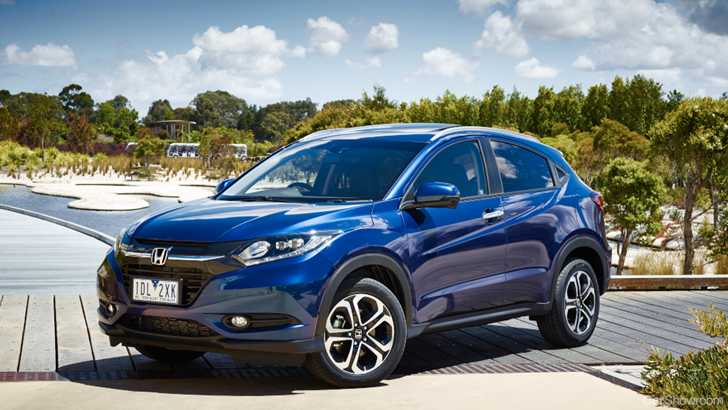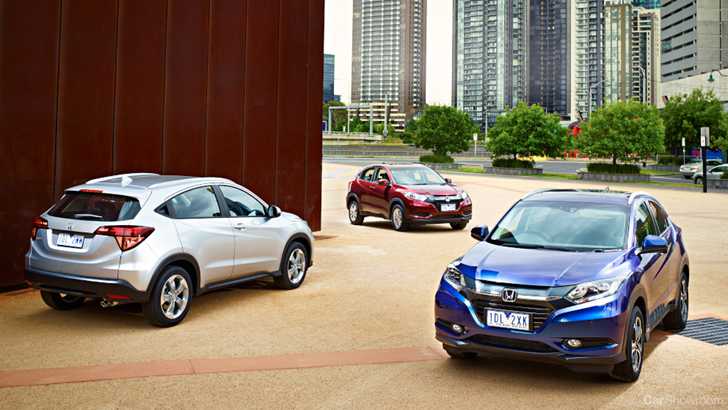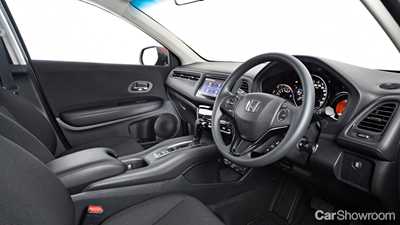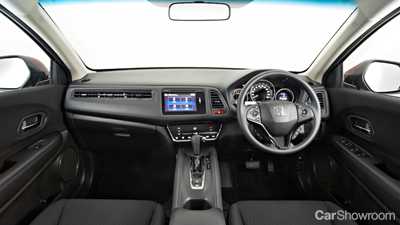We all remember the original Honda HR-V that was well and truly ahead of its time back 1999. 16 years later Honda has revived the name and entered the compact SUV market that it started all those years ago.
The latest Honda HR-V uses the Honda Jazz as its donor car and takes its running gear from the Honda Civic.
Honda HR-V Overview
Honda has introduced the Honda HR-V with a single engine option and four trim levels.
Entry-level is via the VTi which comes with 16” alloy wheels, push button start, six airbags, auto off headlights, Day Running Lights, Cruise control, 7” colour screen, bluetooth, auto hold, and climate control.
The VTi-S adds LED headlights, auto wipers, keyless entry, city brake assist and blind spot assist.
VTi-L ups the ante even further with the addition of front and rear parking systems, paddle shifters, dual zone climate control, leather-heated seats and alloy covered pedals.
The Honda HR-V VTi-L ADAS is the same as the VTi-L but adds Forward Collision Warning, Lane Departure Warning and High-Beam Support System.
A full list of specifications can be found here – 2015 Honda HR-V Specifications.
The 2015 Honda HR-V line-up and pricing:
|
Variant |
Manufacturer's List Price |
Manufacturer's List Price |
|
VTi CVT |
$24,990 |
$25,565 |
|
VTi -S CVT |
$27,990 |
$28,565 |
|
VTi-L CVT |
$32,990 |
$33,565 |
|
VTi-L CVT with ADAS |
$33,990 |
$34,565 |
* Excludes Dealer Delivery and statutory charges
Honda HR-V Engine
The Honda HR-V is powered by a petrol 1.8 litre i-VTEC engine paired with Honda’s Earth Dreams Technology CVT. Delivering drive to the front wheels the HR-V’s 1.8-litre engine produces 105KW @6,500 and 172NM @ 4,300.
Honda Australia claims that the fuel consumption is 6.6 litres per 100 kilometres on the combined cycle. On our 212 kilometer drive in and around Hobart, including four Targa Rally stages we managed 7.4 litres per 100 kilometres.
Those looking for a manual Honda HR-V will need to wait for the diesel engine which is due to be launched later this 2015.
Honda HR-V Interior
The driver-focused cockpit could easily lay claim to being best in segment. Honda has improved the overall appeal of the interior and just like the current fleet of recently launched Mazda’s the Honda HR-V comes with an electric park brake that allows for better use of space. The center console contains nifty cup holders and great storage bins for phones and other items.
The 7” touch screen audio systems and separate climate controls are with in easy reach and are simple to use.
Trying to pair any Bluetooth device requires the car to be stationary, a pain when a passenger could easily pair on the move.
The entry level VTi offers a great level of comfort and technology and is only missing the leather seats of higher grades. Honda has used soft touch materials where required and the stitching used offers a touch of class.
Luggage capacity is 437 litres with 60/40 rear seats in place, fold them flat and this jumps to an impressive 1,032 litres. One of the great features that is fitted to the Honda HR-V is their Magic Seats, the Magic Seats allow the rear cabin to be configured in to 18 different ways.
Honda HR-V Exterior and Styling
When we first heard that Honda had set out to create a car that had the drivability of a sedan, the allure of a coupe and the practicality of a Mini Van we were worried.
We shouldn’t have been – Honda has delivered a stylish looking small SUV. Measuring 1172mm wide, 4294 mm long and 1605mm high the HR-V is neat little package.
Except for the entry-grade VTi the rest of the range receives LED headlights and Daytime Running Lights.
Honda has based the design of the HR-V on their Exciting H Design principals, this means the HR-V gains a “solid wing face”, dark grille, and flared wheel arches to achieve a planted look on the road..
The slopping roof line (creates minor headroom issue for rear passengers over 6-foot) and the large c-pillar is not too dissimilar to the BMW X4.
Honda HR-V On the Road
We sampled the Honda HR-V at the national media launch held out of Hobart, Tasmania.
The drive we took out of Hobart allowed us to sample the HR-V in morning city peak hour traffic and on country roads.
In the morning rush hour drive the HR-V proved to be nimble and responsive and a breeze to drive in town. Taking to the hills outside of Hobart the HR-V continued to perform effortlessly at the signposted speeds.
The HR-V is mainly a urban car that will spend most of its time driving short distances, however those who want to take the HR-V further afield won’t be disappointed.
On some of the Targa Tasmania rally stages that contained a few potholes and mid corner bumps the HR-V exceed our expectations – after all this is a small SUV not a sports car. Honda has used MacPherson struts at the front and a torsion beam rear suspension. Yes it crashed over a few of the larger potholes but it also cornered surprisingly well.
We managed a few kilometers in the entry level VTi and the smaller 16” alloy wheels performed just as well as the larger 17” alloy wheels on the higher spec’d models.
Low noise levels in the cabin are further helped by adding engine, and front and rear floor covers which help block out some of the road noise.
Honda HR-V Issues
The Honda HR-V ticks lots of boxes and will no doubt be a success for Honda.
The lack of android phone integration is still a major blunder and rear air vents should be there. Also the front passenger air vent is never going to win any beauty contests.
Honda HR-V Competition
There is no surprise that Honda is jumping on the small SUV segment in Australia. Every serious player in the market has a competitor to the HR-V.
If we had to part with our cash we would also test drive:
Peugeot 2008 – From $21,990
Mazda CX-3 ( launched next month)- Pricing tbc
Nissan QASQAI – from $25,850
Skoda Yeti - from $23,490
Renault Capture – from $22,990
Honda HR-V Verdict
Honda has a great small SUV on their hands with the HR-V. At the national media launch the HR-V performed far better than we expected.
It might not have a price grabbing headline but the HR-V offers superb ride and handling, with a high level of standard equipment.
The magic seats are a unique offering from Honda that allows flexibility its competitors can only dream of.








































